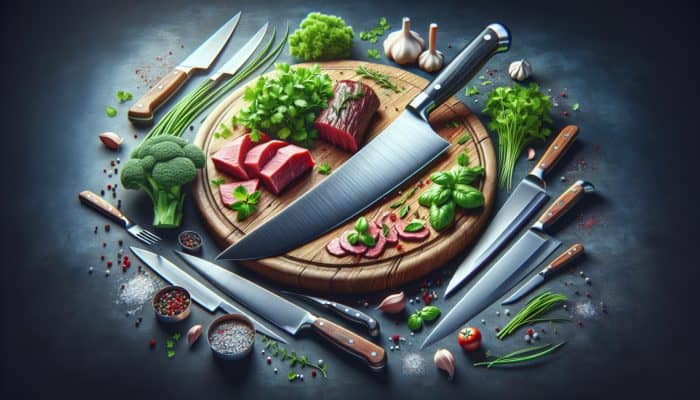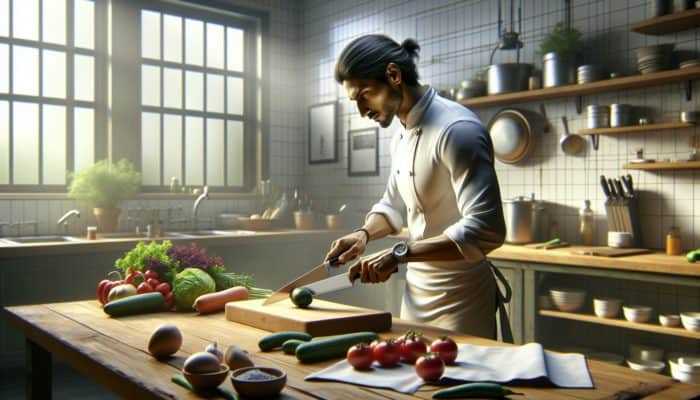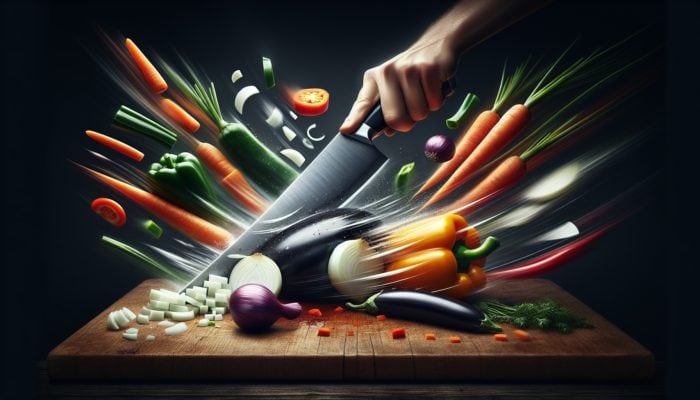Ultimate Guide to Choosing the Perfect Knife for Culinary Excellence
Discovering the Essential Types of Kitchen Knives for Every Culinary Task

Choosing the right knife is a fundamental aspect of mastering chopping skills and advancing your culinary journey. The extensive range of kitchen knives accessible today can significantly improve your chopping efficiency, enhancing your overall cooking experience dramatically. The chef's knife, widely regarded as the cornerstone of any kitchen toolkit, features a broad blade designed specifically to perform a variety of culinary tasks, including slicing, dicing, and mincing. Its versatility prepares you for everything from finely chopping aromatic herbs to managing larger cuts of meat, ensuring you are equipped for any culinary challenge that lies ahead.
On the other hand, the paring knife comes with a smaller blade, expertly designed for intricate tasks like peeling fruits or deveining shrimp, making it an indispensable tool for detailed work where precision is paramount. Additionally, utility knives, often overlooked, play a crucial role in the knife spectrum, serving as a flexible option for various cutting tasks that fall between the chef's knife and the paring knife. Selecting the appropriate type of knife not only enhances your culinary creations but also significantly boosts safety during food preparation. By understanding these classifications, you arm yourself with the confidence needed to handle any ingredient skillfully and effortlessly.
Evaluating Knife Materials to Ensure Superior Performance and Longevity
The material composition of your knife is a critical factor that shapes both your culinary experience and performance in the kitchen. Stainless steel knives are highly favoured for their remarkable resistance to rust and corrosion, making them ideal for a variety of everyday cooking tasks. These knives typically maintain their sharpness effectively; however, regular honing is essential to ensure they operate at peak efficiency. In contrast, carbon steel knives are celebrated for their exceptional edge retention and ease of sharpening, producing an incredibly sharp edge that is highly sought after by many professional chefs. Nonetheless, these knives require diligent maintenance to avoid rust and discolouration over time.
Moreover, ceramic knives provide a lightweight alternative that resists rust, yet they are more susceptible to chipping and thus require careful handling. Each material presents its own unique set of advantages and disadvantages, and comprehending these nuances will guide you in selecting the most suitable knife tailored to your specific cooking style. By opting for the right material, you not only enhance your chopping capabilities but also invest in high-quality tools that elevate your culinary adventures to extraordinary heights.
Determining the Ideal Knife Size and Weight for Optimal Comfort
The size and weight of a knife are essential considerations that significantly affect its effectiveness and your comfort while chopping. A knife that feels well-balanced and comfortable in your hand can make a remarkable difference between efficient chopping and a laborious task. It is crucial to take into account your hand size and the specific chopping techniques you intend to employ. A heavier knife can deliver more force when cutting through tougher vegetables, like squash, but may lead to fatigue during prolonged use.
Conversely, a lightweight knife facilitates quicker and more agile movements, making it ideal for delicate tasks. Taking the time to experiment with various sizes can assist you in discovering your perfect fit, ultimately enhancing your grip and control. By choosing the right knife size that aligns with your personal chopping style, you pave the way for greater mastery over your blade, significantly improving your overall cooking efficiency and enjoyment.
Enhancing Knife Handling Techniques for Safety and Precision

Essential Grip Techniques for Improved Control and Stability
Mastering grip techniques is indispensable when striving to develop superior chopping skills. The pinch grip is a widely recommended technique that enhances control and stability, particularly beneficial for intricate cuts. To achieve this grip, position your thumb and index finger on the blade while wrapping your remaining fingers securely around the handle. This method improves precision and significantly reduces hand fatigue during extended chopping sessions, allowing you to work with greater comfort and efficiency.
Alternatively, adopting the handle grip, where your entire hand envelops the handle, provides a comfortable hold for larger chopping tasks. Each grip method has its unique advantages, and experimenting with both can help you identify which feels more natural for your specific cooking style. By refining your grip techniques, you not only enhance your chopping efficiency but also decrease the risk of accidents, empowering you to cook with increased confidence and skill.
Strategic Hand Positioning for Safe and Effective Chopping
Comprehending proper hand positioning is crucial for both safe and effective chopping. Curling the fingers of your non-dominant hand under while holding the ingredient safeguards your fingertips from the blade. This ‘claw grip’ technique improves visibility and control, allowing you to chop with enhanced precision and safety during meal preparation.
Moreover, maintaining a stable cutting board is essential for achieving optimal results. Ensure that your board is secure and does not slide around while in use; instability can lead to unfortunate accidents. Placing a damp cloth underneath the board can provide additional stability and prevent slips. Proper hand positioning not only accelerates your chopping speed but also reinforces safety, enabling you to focus on the joy of cooking rather than the worry of potential injuries.
Employing a Fluid Chopping Motion for Enhanced Efficiency and Blade Longevity

Adopting a fluid chopping motion is vital for preserving blade sharpness and boosting your cutting speed. Begin with a rhythmic rocking motion, where the tip of the blade remains in contact with the cutting board while the heel of the knife moves up and down. This technique guarantees even cuts and prolongs the lifespan of your blade, as excessive force can dull the edge prematurely.
Practising this motion with a variety of ingredients aids in developing muscle memory, allowing you to chop with increased precision over time. The more you practice, the more efficient and effective your chopping will become. Focusing on your technique ensures that each cut is clean and consistent, imparting a polished and professional appearance to your dishes that will impress your guests.
Essential Knife Maintenance for Longevity and Optimal Performance
Regular knife maintenance is crucial to ensure your culinary tools remain effective and safe during your cooking adventures. Sharpening your knife is vital for preserving its cutting edge, while honing helps realign the blade's edge to optimise its performance. Investing in a high-quality whetstone or honing steel is indispensable for any serious cook aiming to master chopping skills in the kitchen.
Establishing a regimen to assess your knife’s sharpness is essential. A simple test, such as attempting to slice through a piece of paper, can effectively indicate dullness. If you find it challenging to cut through, it’s time to sharpen your knife. By integrating regular maintenance into your cooking routine, you prolong the lifespan of your knives, ensuring they remain reliable companions throughout your culinary journey.
Advanced Techniques for Sharpening Knives with Precision
Mastering the Whetstone Technique for Ultimate Blade Sharpness
Sharpening your knives with a whetstone is a traditional technique that yields outstanding results when executed correctly. To begin, ensure your whetstone is compatible with your knife’s material; most stainless and carbon steel knives respond well to conventional sharpening stones. Soaking the whetstone in water for approximately 10-15 minutes prior to use creates a slurry that facilitates the sharpening process, enhancing its effectiveness.
Position your knife at a 15-20 degree angle against the stone. Start at the heel of the blade and draw it across the stone towards you, applying consistent pressure throughout the action. Repeat this motion several times on each side of the blade to achieve a sharp edge. Although this process may seem daunting initially, with practice, it swiftly becomes second nature. Regular use of a whetstone not only sharpens your knife but also enhances your overall cutting performance, making it an indispensable skill in your culinary toolkit.
Efficient Honing with a Steel to Maintain Blade Integrity
To sustain a knife’s edge between sharpening sessions, honing with a steel is essential. This technique realigns the microscopic teeth of the blade that may become misaligned with regular use. Begin by holding the honing steel vertically, with the tip resting on a stable surface. Position the knife at a 15-degree angle against the steel and draw the blade downwards in a smooth motion, alternating sides to ensure even honing and maintenance.
It is crucial to hone your knife regularly—ideally after every few uses—to keep it performing at its peak efficiency. This straightforward practice extends the intervals between necessary sharpenings, ultimately preserving the life of your knife. By incorporating honing into your routine, you not only enhance your knife's performance but also instill confidence in your chopping abilities.
Utilising Electric Sharpeners for Quick and Convenient Blade Maintenance
Electric sharpeners present a convenient solution for quickly sharpening knives, especially for those who may not yet feel comfortable using a whetstone. When employing an electric sharpener, ensure you adhere to the manufacturer’s guidelines for optimal results. Typically, you will need to feed the knife through the designated slots, allowing the machine to perform the sharpening process for you.
While electric sharpeners can provide a rapid solution, they may occasionally remove more material than necessary, which can shorten the lifespan of your blade. Therefore, it’s essential to use them judiciously and with care. Understanding how to effectively integrate electric sharpeners into your knife care routine will assist you in maintaining maximum sharpness while preserving the integrity of your knives over time.
Essential Chopping Techniques for Culinary Mastery
Mastering Fundamental Chopping Techniques for Aspiring Chefs
Mastering the fundamental chopping techniques is the cornerstone for any aspiring chef eager to elevate their culinary skills to new heights. Start by positioning your knife correctly, ensuring the blade's edge is sharp and ready for effective use. The motion should be smooth and controlled, originating from the wrist rather than the elbow to maintain precision and reduce effort during the chopping process.
Utilising a cutting board with a non-slip surface can significantly enhance your chopping experience. Ensure that the board is clean and free from moisture to prevent slipping during use. Depending on the ingredient, you might opt for a rocking motion or a straightforward down-and-up movement. Consistency is key; practice makes perfect, so dedicate time to refine your technique. Mastering the basics of chopping will lay the foundation for more advanced techniques, allowing your culinary creations to truly shine.
Creating Immaculate Julienne and Batonnet Cuts for Culinary Presentation
Learning how to create thin strips and sticks not only facilitates cooking but also elevates the visual presentation of your dishes. The julienne technique involves slicing vegetables into thin matchstick-sized pieces, which are perfect for salads or as elegant garnishes. Start by cutting the vegetable into manageable sections, then slice each section into thin strips to achieve a uniform appearance that beautifies your dish.
The batonnet technique takes it a step further, producing thicker strips that are ideal for stir-frying or sautéing. This technique necessitates precision, so take your time to ensure uniformity in size. Practising both methods will not only improve your knife skills but also enhance your dishes, providing them with a polished and professional look that is sure to impress anyone at the dining table.
Enhancing Flavours Through Mincing and Dicing Techniques
Mincing herbs and dicing vegetables can significantly elevate the flavour profile of your culinary creations, adding depth and richness to your dishes. When mincing, employ a sharp knife to finely chop herbs, utilising a rocking motion for optimal results. Fresh herbs, when minced correctly, release their essential oils, intensifying the flavours in your dishes and contributing to a more vibrant culinary experience that delights the palate.
Dicing involves cutting vegetables into uniform cubes, which is crucial for consistency in cooking. Start by slicing the vegetable lengthwise, then cross-cut to achieve your desired cube size. Ensuring uniformity in size not only enhances the cooking process but also improves the texture and taste of your dish. Mastering these essential techniques aids in crafting visually appealing and flavour-packed dishes that can impress anyone at the dining table.
Prioritising Safety and Knife Maintenance in the Kitchen
Crucial Knife Safety Tips to Avoid Kitchen Injuries
Implementing fundamental safety practices while chopping is imperative for preventing accidents in the kitchen. Always use a cutting board specifically designed for knife work, as it provides a stable and safe surface for your chopping tasks. Ensure that your knife is sharp; dull blades require more force, increasing the risk of slips and injuries.
Moreover, maintaining an organised workspace is vital for safety. Remove unnecessary objects from your cutting area, and remain aware of your surroundings while chopping. If you need to reach for an ingredient, stop chopping first to avoid accidents. A clean and focused kitchen environment is critical for maintaining safety while honing your skills in chopping techniques.
Effective Cleaning and Storage Techniques for Knife Longevity
Proper cleaning and storage methods significantly impact your knife's longevity and overall performance. After each use, promptly clean your knives with warm, soapy water, and avoid placing them in the dishwasher; this can damage the blade and reduce its effectiveness over time. Be sure to dry your knife thoroughly to prevent rusting, especially with carbon steel knives that are more susceptible to moisture.
For storage, consider using a magnetic strip or a knife block to protect the blades and maintain their sharpness. Avoid tossing knives into a drawer where they can dull or sustain damage. Thoughtful storage practices extend the life of your knives, ensuring they remain reliable tools in your culinary arsenal and are always ready for your next cooking adventure.
Implementing Regular Maintenance for Optimal Knife Performance
Routine checks and maintenance tasks are essential for keeping your knives in top condition and ready for use. Regularly inspect your knives for nicks or damage, and address any issues promptly to prevent further complications. Learning to recognise when your knife needs sharpening or honing is a crucial part of effective knife maintenance and care.
Investing time in maintaining your knives ensures they remain effective, reliable tools for any culinary challenge. By embracing these practices, you not only improve your skills but also develop a deeper appreciation for the tools that elevate your cooking experience, enabling you to create exceptional dishes with ease and confidence.
Strategies for Enhancing Chopping Speed and Efficiency
Incorporating Practice Drills for Improved Speed and Accuracy
To significantly boost your chopping speed and accuracy, integrating effective practice drills into your routine is essential. Dedicate specific periods to practice various techniques, such as julienne or dicing, using a timer to track your progress and improvement. Start slowly, focusing on precision before gradually increasing your speed as you gain confidence in your abilities.
Engaging in these drills regularly helps develop muscle memory, allowing for quicker and more efficient movements while chopping. Consider using ingredients with different textures to challenge your skills and improve your adaptability in the kitchen. As you practice, you’ll notice a marked improvement in both your speed and confidence, ultimately enhancing your overall cooking experience and efficiency in the kitchen.
Utilising Muscle Memory for Faster and More Efficient Chopping Techniques
Developing muscle memory is essential for executing fast and efficient chopping movements. The more you repeat specific chopping techniques, the more automatic they become. Begin with slow, deliberate movements before gradually increasing your speed as your confidence builds and your technique improves over time.
Incorporate variations in ingredients and techniques during your practice sessions to keep your training engaging and stimulating. Repetition is key; over time, you’ll find your hands intuitively know the right motions, enhancing both your speed and accuracy. By fostering muscle memory, you position yourself for success in any culinary endeavour, enabling you to create dishes with ease and finesse.
Effective Time Management for Streamlined Meal Preparation
Effectively managing time during meal preparation can significantly boost your chopping speed and overall efficiency. Organising your workspace before you begin cooking can streamline the process; gather all necessary ingredients and tools so everything is easily accessible, reducing the time spent searching for items during cooking.
Setting a timer for each stage of preparation can keep you focused and encourage quicker chopping without sacrificing quality. This practice fosters a more efficient cooking environment and helps you learn to chop faster while maintaining precision. Being mindful of your time not only aids in cooking but also enhances your enjoyment of the entire culinary experience, from preparation to plating.
Enhancing Chopping Precision for Professional-Quality Results
Improving Knife Control for Consistent and Precise Cuts
Enhancing knife control is essential for achieving precise and consistent cuts in your culinary tasks. Start by practising with a dull knife; this will compel you to concentrate on your technique rather than relying solely on the sharpness of the blade. As you gain confidence, switch to a sharper knife and apply the skills you’ve developed to maintain control and accuracy throughout your chopping tasks.
Utilise techniques such as the claw grip to protect your fingers while retaining mastery over the knife’s movement. Consistent practice with various ingredients will further refine your skills, enabling you to handle even the most challenging vegetables with ease. Ultimately, improved knife control leads to better results in your culinary creations, allowing you to impress your guests with beautifully crafted dishes that showcase your culinary talents.
Setting Up an Efficient Cutting Board for Optimal Performance
Optimising your cutting board setup can greatly enhance visibility and control during chopping tasks. Ensure your cutting board is positioned at a comfortable height to minimise strain on your back and arms. A non-slip mat beneath the board can prevent unwanted movement, facilitating safer and more efficient chopping.
Consider the arrangement of your ingredients, placing them within easy reach to minimise unnecessary movements. A clutter-free workspace not only aids in maintaining focus but also promotes better control over your knife. Taking the time to create an efficient cutting board setup allows you to enhance your chopping precision and enjoy a more productive cooking session, ultimately leading to superior culinary results.
Preparing Ingredients for Enhanced Chopping Efficiency
Proper preparation of ingredients is critical for facilitating precise and efficient chopping. Thoroughly wash and dry vegetables to prevent slipping and ensure clean cuts. For items with tough exteriors, such as squashes, start by trimming off the ends to create a stable base for chopping.
Consider pre-cutting larger items into manageable sizes before chopping, as this can expedite the process and improve overall accuracy. A well-prepared workspace lays the foundation for effective chopping, enabling you to focus on honing your skills while creating beautiful, delicious dishes that showcase your culinary talents and creativity.
Adapting Chopping Techniques for Various Ingredients
Customising Chopping Techniques for Different Vegetables
When chopping various vegetables, the techniques may vary based on their unique texture and firmness. For softer vegetables like tomatoes, opt for a serrated knife to prevent squishing, while hard vegetables such as carrots benefit from a sharp chef's knife for clean, precise cuts that enhance the cooking process.
Understanding the distinctive properties of each vegetable enables you to apply the most suitable technique, ultimately enhancing both flavour and texture in your dishes. Practising with a variety of vegetables will not only improve your skills but also foster a greater appreciation for the ingredients you work with, enabling you to create dishes that truly shine and delight the senses.
Handling Meat Safely and Efficiently with Proper Techniques
Handling meats requires specific techniques to ensure safety and precision during chopping. Always use a separate cutting board dedicated to meats to avoid cross-contamination with other ingredients, thus maintaining food safety standards. For tougher cuts, allow the knife to do the work; employ a sharp knife to glide through without applying excessive force, resulting in cleaner cuts.
Cutting against the grain can improve tenderness, thereby enhancing the overall eating experience of your dishes. Practice makes perfect; enhancing your skills with meat preparation can elevate your culinary creations, allowing you to impress friends and family with expertly prepared dishes that showcase your talents and culinary knowledge.
Creative Substitutions for Ingredients in Your Recipes
Finding suitable replacements for unavailable ingredients can be a daunting task, but understanding how to adapt allows you to maintain dish quality without compromising on taste. Familiarise yourself with flavour profiles and textures of common ingredients to ensure your substitutions work harmoniously within the recipe, creating a balanced dish.
For instance, if a dish calls for a specific herb or spice that you can’t find, consider using dried alternatives or similar flavours to achieve a comparable taste. Developing a repertoire of substitutions can enhance your cooking confidence, empowering you to tackle any challenge in the kitchen while mastering chopping skills and expanding your culinary creativity.
Adjusting Seasonings for Perfectly Balanced Flavours
Adjusting seasonings to complement different ingredients and personal taste preferences is vital for creating memorable and flavourful dishes. Cultivating a palate for balancing flavours—understanding how salt, acidity, and sweetness interact—can transform a dish from average to extraordinary, delighting those who partake.
When substituting ingredients, it’s important to recalibrate your seasoning levels accordingly. For example, if replacing a milder vegetable with a more robust option, be prepared to adjust the amount of salt and spices to maintain balance in the dish. Mastering the art of seasoning not only elevates your culinary creations but also enhances your overall cooking skills, enabling you to craft culinary masterpieces that impress and satisfy.
Your Frequently Asked Questions Addressed
What is the best type of knife for a beginner chef?
A chef's knife is frequently recommended for beginner chefs due to its versatility and ability to effectively perform a wide range of culinary tasks, making it an excellent starter knife.
How often should I sharpen my kitchen knives?
It’s advisable to sharpen your knives every few months, depending on your frequency of use. Regular honing can extend the time between necessary sharpenings, keeping your knives in optimal condition.
Can I use a whetstone for ceramic knives?
No, ceramic knives require specific diamond sharpeners, as they are too hard for traditional whetstones to effectively sharpen without causing damage.
What is the difference between honing and sharpening a knife?
Honing realigns the blade's edge, while sharpening removes material to create a new edge. Both processes are essential for proper knife maintenance and performance.
How should I clean my knives after use?
Clean your knives with warm, soapy water immediately after use. Avoid placing them in the dishwasher, as this can damage the blades over time and reduce their effectiveness.
What is the best way to store my kitchen knives?
Store knives in a magnetic strip or a knife block to protect the blades and keep them sharp for longer periods, ensuring they remain ready for use.
How can I improve my chopping speed?
Regular practice, establishing a dedicated routine, and utilising cutting drills can significantly enhance your chopping speed and overall efficiency in the kitchen, making meal prep more enjoyable.
Are electric sharpeners suitable for all knife types?
Electric sharpeners work well for many knives but can sometimes remove more material than necessary, so it’s important to use them judiciously and infrequently to preserve your knife’s integrity.
What is the claw grip technique in knife handling?
The claw grip is a hand positioning technique where your non-dominant hand holds the food with fingers curled under, keeping them safe from the knife blade during chopping.
How do I know when my knife needs sharpening?
If your knife struggles to cut through paper or requires excessive force to slice through ingredients, it's indicative that it’s time to sharpen your knife for optimal performance.
Join Us on Facebook for More Culinary Tips!
The post How to Sharpen Your Chopping Skills: A Universal Guide appeared first on https://cookinggods.com
The Article Sharpen Your Chopping Skills with This Universal Guide Was Found On https://limitsofstrategy.com

